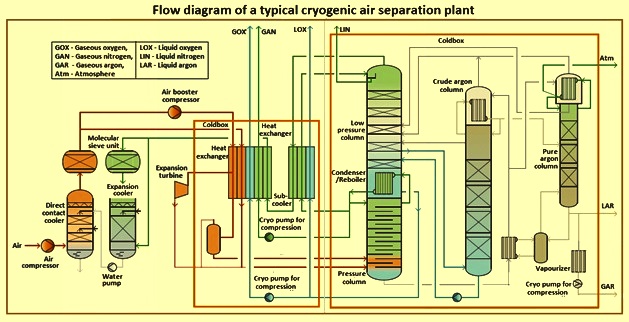- A-29, Industrial Area, Site IV,
Sahibabad, Ghaziabad, UP, India. - (+91-120) 2896063
info@bhartiyagroups.com


The Cryogenic Air Separation Unit (CASU) provides high purity oxygen, nitrogen and argon in a single integrated process package. Each CASU is designed to a specific application and offers a wide range of performance capabilities. Proper selection of a particular CASU can provide a competitive advantage while meeting your commercial, military or space application's requirements.
Cryogenic air separation units are used with either the Pressure Swing Adsorption or Vacuum Pressure Swing Adsorption systems. These systems separate air by removing water vapor via pressure swing adsorption (PSA) or vacuum pressure swing adsorption (VPSA), and purifying the remaining contents of one or more components, such as nitrogen and/or argon, oxygen and sometimes other gases."
Cryogenic oxygen is used in cryosurgery and in the treatment of certain cancers, by destroying the tumors with extreme cold temperatures [1]. It is also used in sports medicine. Treatment of atherosclerosis (the hardening of arteries) with cry lipolysis uses crystals to freeze fat cells and cause them to rupture, triggering a natural process that reabsorbs them [2]. Cry lipolysis is also being investigated as a possible treatment for obesity by harvesting the fat removed [3]. As a propellant, it was first proposed as a cheaper alternative to liquefied gases such as.
Cryogenic oxygen is produced at extremely low temperatures (-196°C). The lower its temperature, the fewer the amount of molecules. By expanding the number of molecules in a given volume, this gas can deliver oxygen to a patient faster as compared to other gases. It is widely used for treating neonatal respiratory distress syndrome. It is also used for patients suffering from arthritis and lupus, especially when delivered in combination with other therapies.
Bhartiya Cryogas is top Cryogenic Oxygen plant manufacturer in India. It is also the biggest Cryogenic oxygen supplier in India. It manufactures and supplies cryogenic liquid oxygen/nitrogen plants as a product mix mode. It has a leak-proof stainless steel column and skid mounted version for storage of high purity medical and industrial oxygen.
The company adopts the following manufacturing process to produce cryogenic oxygen.
1. Compression of Atmospheric Air By Air Compressor
In this process, the free saturated air is sucked from the atmosphere through a highly efficient dry-type suction filter into the first stage of the horizontal balanced opposed, lubricated reciprocating air compressor. Compressed air is chilled to 12 degree centigrade in a chilling unit at a temperature of 12 degree centigrade and then moved to a moisture separator where the condensed moisture gets removed before entering into Molecular Sieve Battery. Before sending the air to MOLECULAR SIEVE BATTERY, air is passed through an OIL ABSORBER where air becomes oil free.
2. Purification of Air by Process Skid
In the process, chilled air passes through the Molecular Sieve Battery consisting of Twin Towers packed with Molecular Sieves to remove moisture and Carbon dioxide present in the air. Molecular Sieve Battery operates on Twin Tower System, when one tower is under production the other tower is regenerated by passing waste Nitrogen gas at 200 degree Celsius through a reactivation heater. After an interval of 8 to 10 hours, the tower under production gets exhausted and regenerated by similar process before use and thus the cycle continues. Any dust particles get filtered in the DUST FILTER before air enters the AIR SEPARATION COLUMN.
3. Cooling of Air by Expansion Engine (Expander)
In this process air before liquefaction in the air separation plant needs to be cooled to temperatures of sub-zero (cryogenic). The main portion of the air after the process enters the expansion engine through the heat exchanger no. 1 after pre-cooling. The temperature of the air drops to around -165 degree Celsius by the help of Expander. It has highly efficient advanced design with Teflon piston rings and a fully hydraulic mechanism with leak proof ball valves.
4. Separation If Liquid Air into Oxygen and Nitrogen by Air Separation Column
In the process, Chilled, Oil free and moisture free air enters into multi-pass HEAT EXCHANGER NO.I where it gets cooled to (-80) degree Celsius by cold gained from outgoing waste Nitrogen and Oxygen. A part of air then enters a multi-pass HEAT EXCHANGER NO. II or LIQUIFIER made of special Alloy tubes. This air cools to (-170) degree Celsius before passing through an expansion valve. Due to joule Thomson Effect, after the expansion valve, air gets further cooled down and gets liquefied before entering into the bottom column is known as rich liquid.
Cryogenic oxygen plant manufacturer in India, Cryogenic oxygen plant suppliers in India, Cryogenic oxygen plant, Cryogenic oxygen plant manufacturer, CryoSurgery, Pressure Swing Adsorption (PSA), Vacuum Pressure Swing Adsorption (VPSA)







